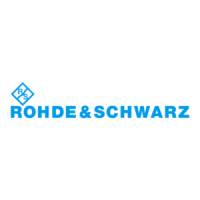Concepts and features
R&S
®
ZNA
174User Manual 1178.6462.02 ─ 20
●
The loss is the energy loss along the transmission line due to the skin effect. For
resistive lines and at RF frequencies, the loss is approximately proportional to the
square root of the frequency.
In Keysight mode, the offset loss is expressed in units of Ω/s at a frequency of 1
GHz. The following formula holds for two-port standards:
sdelaydB
ZdBLoss
sLossOffset
//3429.4
//
//
0
The conversion formula for one-port standards has an additional factor ½ on the
right-hand side. The reason for this factor is that the Loss in dB accounts for the
attenuation along the forward and the reverse path. It does not depend on how
often the wave actually propagates through the line, whereas the offset loss is pro-
portional to the attenuation of the line.
To determine an offset loss value experimentally, measure the delay in seconds
and the loss in dB at 1 GHz and use the formula above.
The default loss or offset loss is zero.
The impedance for waveguides is frequency-dependent. If a waveguide line type is
selected in the "Cal Connector Types" dialog, the "Char. Imp." field is disabled and indi-
cates "varies" instead of a definite impedance value. Moreover no loss or offset loss
can be set.
Offset parameters and standard types
Offset parameters are used to describe all types of standards except the Sliding Match
and the Attenuation.
●
The Sliding Match is a one-port standard with variable load parameters (sliding
load) and unspecified length. The reference impedance is fixed and equal to the
characteristic impedance of the connector type. No load and offset parameters
need to be set.
●
The Attenuation is a two-port standard which is fully matched in both directions (the
reflection factor at both ports is zero). No load and offset parameters need to be
set.
Load parameters and standard types
Load parameters are used to describe all types of standards except a Through, a Slid-
ing Match, a Line, and an Attenuation.
●
The Through standard is a through-connection between two ports with minimum
loss which is taken into account by the offset parameters.
●
The Sliding Match is a one-port standard with variable load parameters (sliding
load), so there is no fixed load model.
●
The Line standard is a line of variable length with minimum loss which is taken into
account by the offset parameters.
●
The Attenuation is a two-port standard which is fully matched in both directions (the
reflection factor at both ports is zero). No load and offset parameters need to be
set.
Calibration

